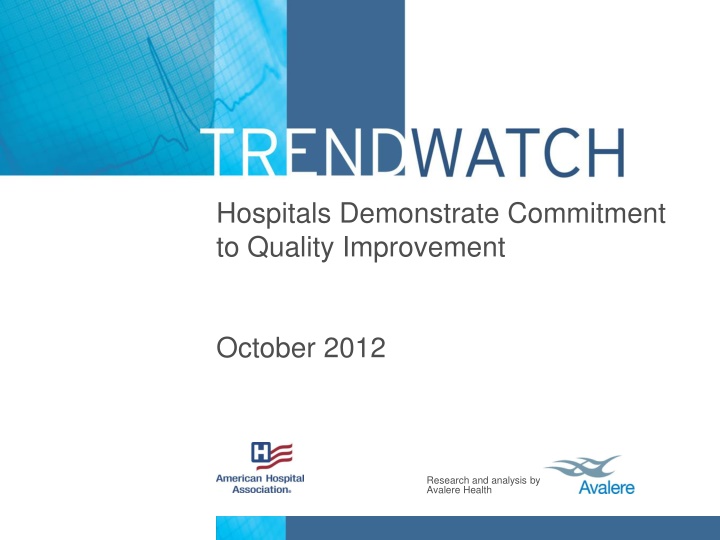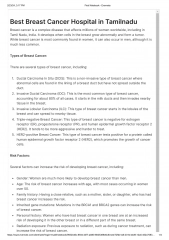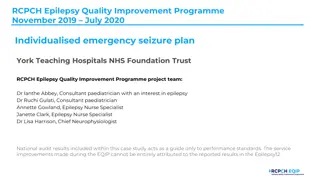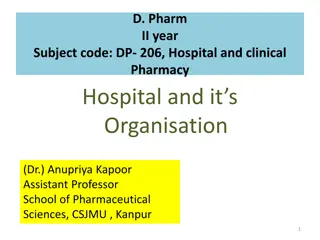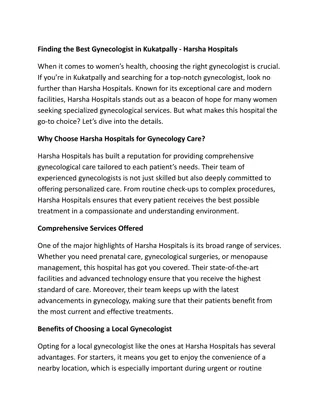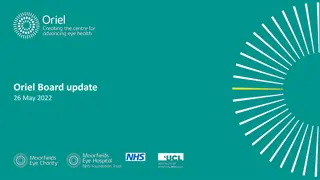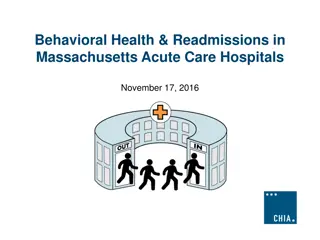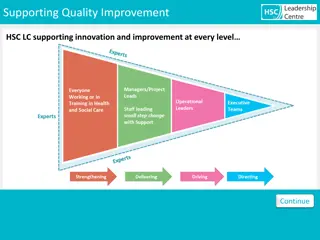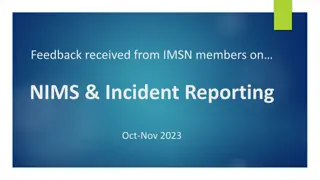Hospitals Demonstrate Commitment to Quality Improvement
Hospitals in October 2012 were evaluated for their commitment to quality improvement by Avalere Health. This research and analysis study sheds light on the efforts made by hospitals to enhance quality standards and patient care. Discover the key findings and insights from this report about the healthcare industry's dedication to quality improvement initiatives.
Download Presentation

Please find below an Image/Link to download the presentation.
The content on the website is provided AS IS for your information and personal use only. It may not be sold, licensed, or shared on other websites without obtaining consent from the author.If you encounter any issues during the download, it is possible that the publisher has removed the file from their server.
You are allowed to download the files provided on this website for personal or commercial use, subject to the condition that they are used lawfully. All files are the property of their respective owners.
The content on the website is provided AS IS for your information and personal use only. It may not be sold, licensed, or shared on other websites without obtaining consent from the author.
E N D
Presentation Transcript
Hospitals Demonstrate Commitment to Quality Improvement October 2012 Research and analysis by Avalere Health
Quality improvement can be viewed as a five-step process. Chart 1: Five Steps to Improving Quality Identify Target Areas for Improvement Determine What Processes Can Be Modified to Improve Outcomes Disseminate Results to Spur Broad Quality Improvement Develop and Execute Effective Strategies to Improve Quality Track Performance and Outcomes Source: Analysis by Avalere Health and American Hospital Association. Research and analysis by Avalere Health
Hospitals engage with government agencies and non-governmental bodies on quality improvement. Chart 2: Sample of Hospital Quality Improvement Partners and Entities Centers for Disease Control and Prevention National Quality Forum Agency for Healthcare Research and Quality Disease Groups (e.g., American Heart Association) The Joint Commission Centers for Medicare & Medicaid Services Private Payers Professional Societies Health Resources and Services Administration Quality Improvement Initiatives Institute for Healthcare Improvement Department of Veterans Affairs Premier/ VHA/ Group Purchasing Organizations Department of Health and Human Services Health Research and Educational Trust Partnership for Patients Public Health Agencies Regional Collaboratives States Source: Analysis by Avalere Health and American Hospital Association. Research and analysis by Avalere Health
National quality campaigns have improved hospital delivery of cardiac care. Chart 3: Percentage of Patients Undergoing Percutaneous Coronary Interventions within 90 Minutes of Arrival at a Hospital, 2007 2011 94% 91% 87% 82% 72% Percentage of Patients 2007 2008 2009 2010 2011 Source: The Joint Commission. Improving America s Hospitals: The Joint Commission s Annual Report on Quality and Safety 2012. Research and analysis by Avalere Health
Evidence-based protocols have improved quality in intensive care units (ICUs). Chart 4: CLABSIs per 1,000 Central Line Days at Hospitals Participating in Michigan Hospital Association (MHA) Keystone: ICU, 2004 2009 CLABSIs per 1,000 Central Line Days 2.50 1.39 1.18 1.17 0.98 0.86 2004 2005 2006 2007 2008 2009 Source: MHA Keystone Center for Patient Safety & Quality. 2010 Annual Report. Research and analysis by Avalere Health
Hospitals have progressed in combating hospital- acquired infections Chart 5: Central Line-associated Bloodstream Infection (CLABSI) Standardized Infection Ratio (SIR), 2006 2010 1.2 Standardized Infection Ratio 1.0 0.8 0.6 0.4 0.2 0.0 2006-2008 (base) 2009 2010 Source: U.S. Department of Health and Human Services. Health System Measurement Project. Central Line- Associated Bloodstream Infection Standardized Infection Ratio. Note: SIR is a ratio of the observed number of CLABSI as reported to CDC's National Healthcare Safety Network (NHSN) each year to the predicted occurrence based on the rates of infections among all facilities reporting to NHSN during the referent period (January 2006 through December 2008). SIR below 1.0 means hospitals reported fewer infections than predicted. Research and analysis by Avalere Health
and in adhering to accepted treatment protocols. Chart 6: Adult Surgery Patients Who Received Appropriate Timing of Antibiotics, by Age, 2005 2009 100% 95% 90% Percent of Patients 85% Under 65 80% 65-74 75% 75-84 70% 85 and Over 65% 60% 2005 2006 2007 2008 2009 Source: U.S. Department of Health and Human Services. (2011). National Healthcare Quality Report. Washington, DC: Agency for Healthcare Research and Quality. Research and analysis by Avalere Health
Hospital efforts to curb infections have produced impressive results. Chart 7: Percentage of On the CUSP: Stop BSI Intensive Care Units (ICUs) with Zero Percent Central Line-associated Bloodstream Infection (CLABSI) Rate 80% 70% Intervention Percent of Units (N=660) 60% 50% 40% 30% 20% 12 Months Before Intervention 1-3 Months Post Intervention 4-6 Months Post Intervention 7-9 Months Post Intervention 10-12 Months Post Intervention Source: Agency for Healthcare Research and Quality. CLABSI Update. http://www.ahrq.gov/qual/clabsiupdate/clabsiupdate.pdf. Note: To achieve a zero percent CLABSI rate, an ICU had to report no CLABSIs for each data point submitted during the period. Research and analysis by Avalere Health
Collaboration to develop and implement multiple interventions across a system can yield quality gains. Chart 8: Unadjusted Mortality Decline and Case-mix Index in Hospitals in the Ascension Health System, 2004 2010 2.4 Deaths per 100 Discharges Case-mix Index 1.49 2.2 Deaths per 100 Discharges 1.47 2 1.45 Case-mix Index 1.8 1.43 1.6 1.41 1.4 1.39 1.2 1.37 1 1.35 2004 2005 2006 2007 2008 2009 2010 Source: Pryor, D., et al. (April 2011). The Quality Journey At Ascension Health: How We ve Prevented At Least 1,500 Avoidable Deaths A Year And Aim To Do Even Better. Health Affairs, 30(4): 604-611. Research and analysis by Avalere Health
Broad dissemination of quality improvement successes can improve outcomes across a hospital system. Chart 9: System-wide Infection Counts at Legacy Health, 2008 and 2010 90 80 70 Deaths per 100 Discharges Baseline Performance (March 2008) 60 50 Performance at End of Study (March 2010) 40 30 20 10 0 Catheter-associated Urinary Tract Infection Surgical-site Infection Total Infections Source: Joyce, J., et al. (2011). Legacy Health's 'Big Aims' Initiative To Improve Patient Safety Reduced Rates Of Infection And Mortality Among Patients. Health Affairs, 30(4): 619-627. Research and analysis by Avalere Health
More hospitals are adhering to accepted surgery care guidelines. Chart 10: Rate of Adherence to Surgical Care Improvement Project (SCIP) Process Measures, Fiscal Years (FY) 2008 and 2009 100% 98% 96% 94% Rate of Adherence 92% 90% FY 2008 88% FY 2009 86% 84% 82% 80% Antibiotics within 1 hour before incision or within 2 hours if vancomycin or quinolone is used Received prophylactic antibiotics consistent with recommendations Prophylactic antibiotics discontinued within 24 hours of surgery end time or 48 hours for cardiac surgery Controlled 6 am postoperative serum glucose for cardiac surgery patients Appropriate hair removal for surgery patients Source: Centers for Medicare and Medicaid Services. Progress Toward Eliminating Healthcare-Associated Infections September 23-24, 2010. http://www.hhs.gov/ash/initiatives/hai/actionplan/cms_scip.pdf. Research and analysis by Avalere Health
Hospitals are advancing on evidence-based quality measures. Chart 11: Percentage of Hospitals Achieving Composite Rates Greater Than 90 Percent for Accountability Measures, 2007 and 2011 100% 90% 80% Percentage of Hospitals 70% 2007 2011 60% 50% 40% 30% 20% 10% 0% Heart Attack Pneumonia Surgical Care Children's Asthma Source: The Joint Commission. Improving America s Hospitals: The Joint Commission s Annual Report on Quality and Safety 2012. Research and analysis by Avalere Health
Hospitals quality initiatives are yielding better patient outcomes. Chart 12: Inpatient Deaths per 1,000 Adult Hospital Admissions with Heart Attack, by Age, 2000 2008 160 Deaths per 1,000 Admissions 140 120 100 65 and over 80 60 Total 40 45-64 20 18-44 0 2000 2004 2005 2007 2008 Source: U.S. Department of Health and Human Services. (2011). National Healthcare Quality Report. Washington, DC: Agency for Healthcare Research and Quality. Research and analysis by Avalere Health
